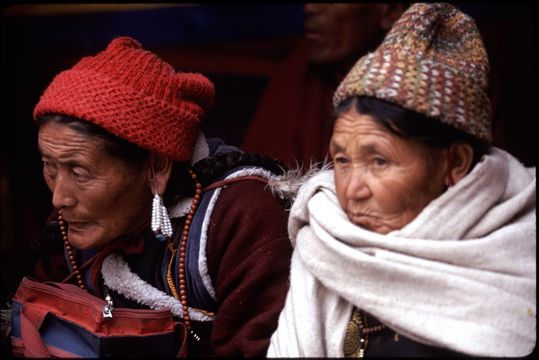 Women watching the winter festival at the Spituk Gompa, just outside of Leh in Ladakh, northern India.
Women watching the winter festival at the Spituk Gompa, just outside of Leh in Ladakh, northern India. |
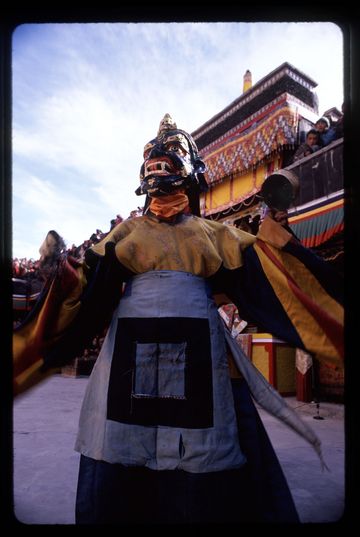 Monk in costume for the winter festival at the Spituk Gompa, just outside of Leh in Ladakh, northern India.
Monk in costume for the winter festival at the Spituk Gompa, just outside of Leh in Ladakh, northern India. |
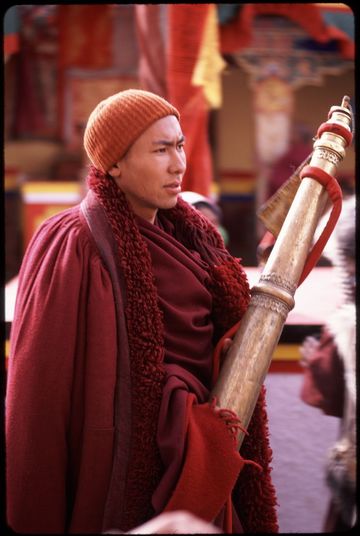 Monk carrying a Tibetan great horn, or dungchen, at the Spituk monastery winter festival.
Monk carrying a Tibetan great horn, or dungchen, at the Spituk monastery winter festival. |
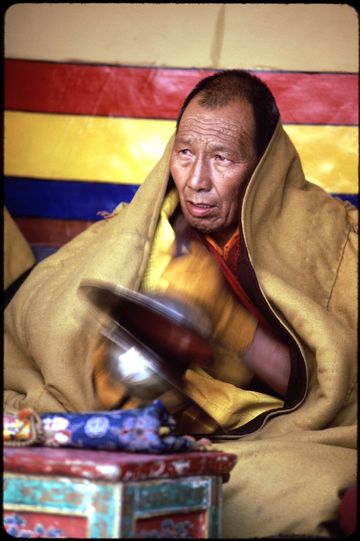 Monk playing Tibetan cymbals (rolmo), at the Spituk monastery winter festival.
Monk playing Tibetan cymbals (rolmo), at the Spituk monastery winter festival. |
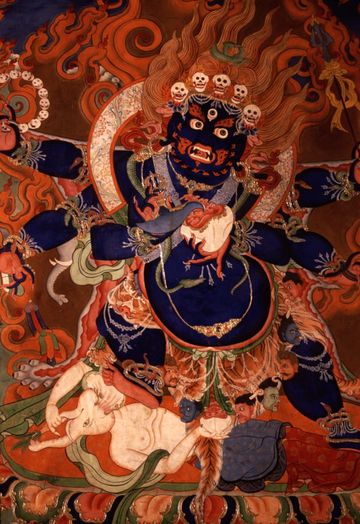 Tibetan god painted on the wall of the Gompa at Likir, Ladakh.
Tibetan god painted on the wall of the Gompa at Likir, Ladakh. |
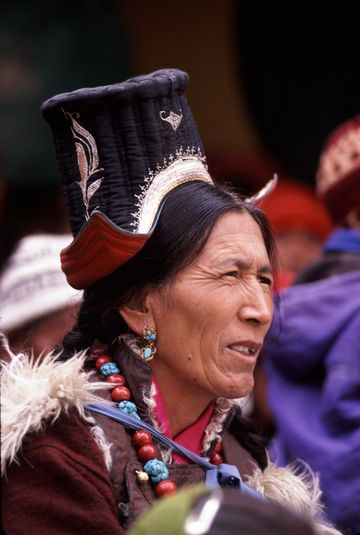 Ladakhi woman watching the spectacle at the Spituk Winter Festival.
Ladakhi woman watching the spectacle at the Spituk Winter Festival. |
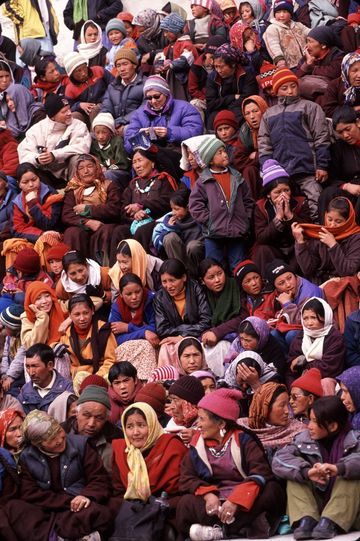 The crowd watching the Spituk Festival. Can you spot the two Polish people?
The crowd watching the Spituk Festival. Can you spot the two Polish people? |
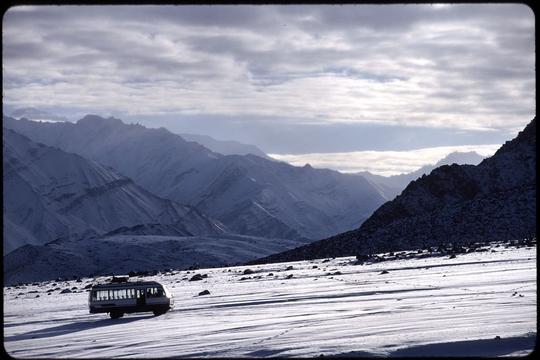 The bus from Leh to Likir, a small town in Ladakh, after it dropped me off in Likir.
The bus from Leh to Likir, a small town in Ladakh, after it dropped me off in Likir. |
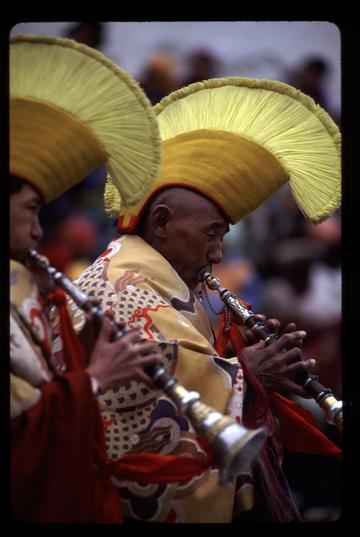 Monks playing gyalings at the winter festival at the Spituk Gompa, just outside of Leh in Ladakh, northern India.
Monks playing gyalings at the winter festival at the Spituk Gompa, just outside of Leh in Ladakh, northern India. |
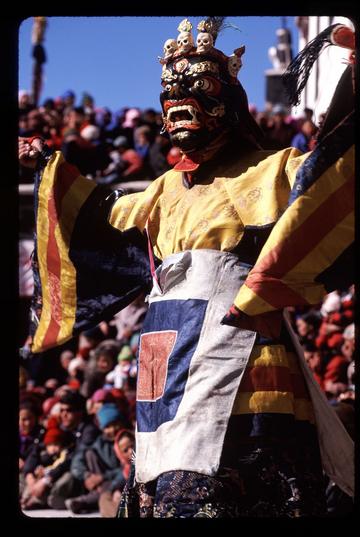 Monk in costume for the winter festival at the Spituk Gompa, just outside of Leh in Ladakh, northern India.
Monk in costume for the winter festival at the Spituk Gompa, just outside of Leh in Ladakh, northern India. |
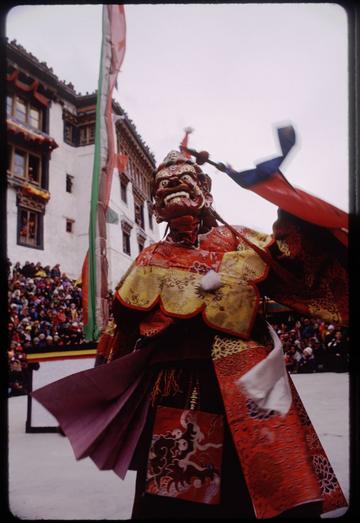 Monk in red-faced mask (perhaps representing the god Pektse?) at the winter festival at the Spituk Gompa, just outside of Leh in Ladakh, northern India.
Monk in red-faced mask (perhaps representing the god Pektse?) at the winter festival at the Spituk Gompa, just outside of Leh in Ladakh, northern India. |
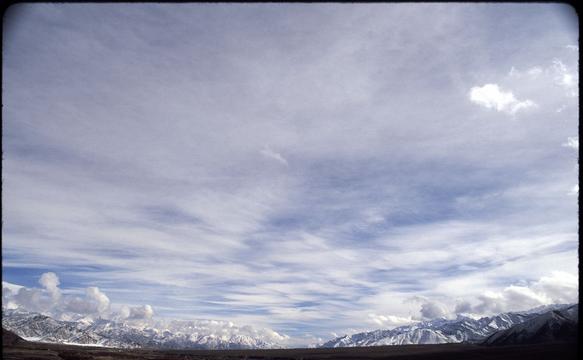 The sky above the Spituk Monastery, near Leh.
The sky above the Spituk Monastery, near Leh. |
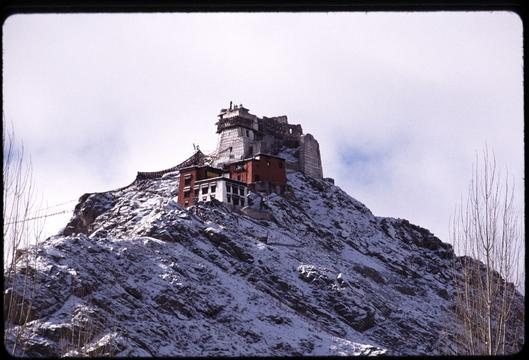 The gompa of Leh.
The gompa of Leh. |
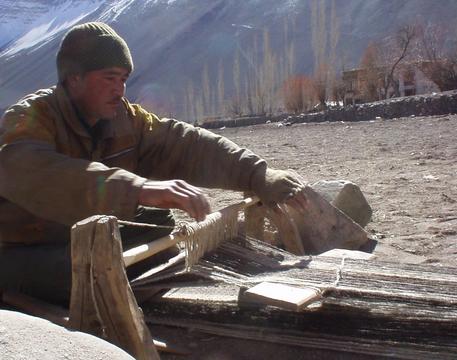 Ladakhi man weaving a woolen mat in the town of Alchi.
Ladakhi man weaving a woolen mat in the town of Alchi. |
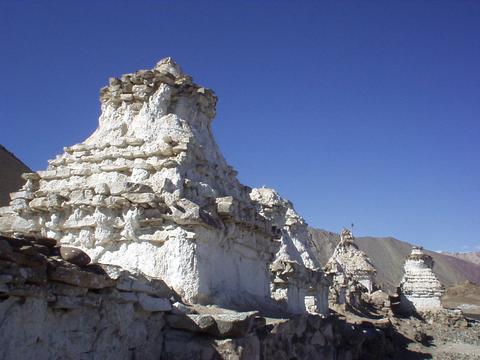 Stupas outside of the town of Alchi. A boy that walked with me for a little while explained that (at least in the old days), a mountain would get upset and now allow the farmers' crops to grow, and so they would build stupas like these to combat the mountain's ill will.
Stupas outside of the town of Alchi. A boy that walked with me for a little while explained that (at least in the old days), a mountain would get upset and now allow the farmers' crops to grow, and so they would build stupas like these to combat the mountain's ill will. |
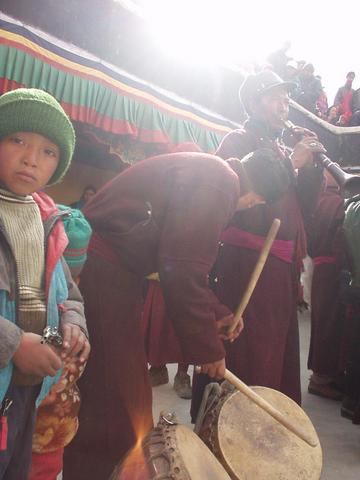 Men playing drums and tibetan horn at the 2003 Spituk Festival; these two (not the kid) played music at the beginning and ending of each day of the festival.
Men playing drums and tibetan horn at the 2003 Spituk Festival; these two (not the kid) played music at the beginning and ending of each day of the festival. |
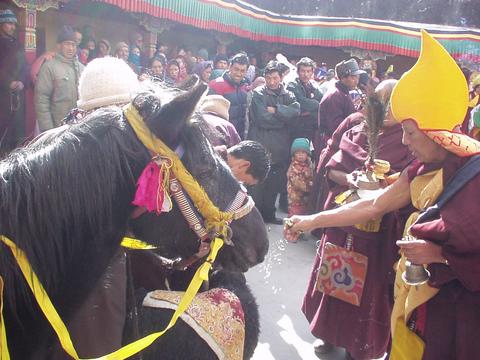 Ladakhi monk blessing animals: there was a horse, a ram, and a dog.
Ladakhi monk blessing animals: there was a horse, a ram, and a dog. |
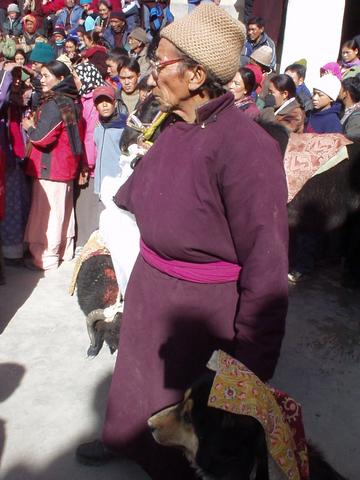 The horse and the ram were more or less willing participants in the festival, but the dog was displeased to be present, snapping and growling at anyone who came near; the monk here was holding him on a very short chain.
The horse and the ram were more or less willing participants in the festival, but the dog was displeased to be present, snapping and growling at anyone who came near; the monk here was holding him on a very short chain. |
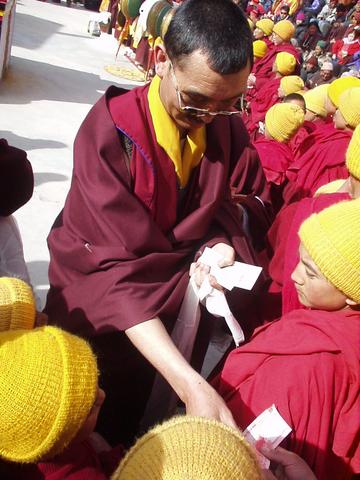 The offering of gifts was a big part of the festival, with the public offering ceremonial white cloths (they have a name, I forget), oil, and other things to the monastery, and with the older monks giving small amounts of money to the young monks.
The offering of gifts was a big part of the festival, with the public offering ceremonial white cloths (they have a name, I forget), oil, and other things to the monastery, and with the older monks giving small amounts of money to the young monks. |
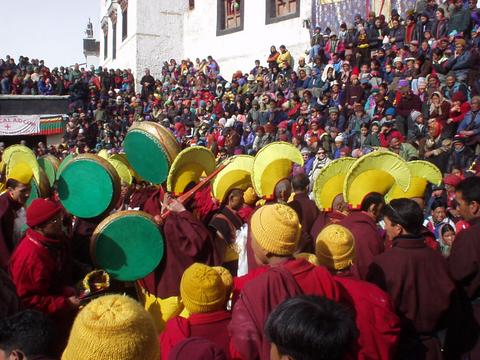 The recession of the music-playing monks at the intermission of the second day of the festival; the main instruments were drums (the green things) and very large horns.
The recession of the music-playing monks at the intermission of the second day of the festival; the main instruments were drums (the green things) and very large horns. |
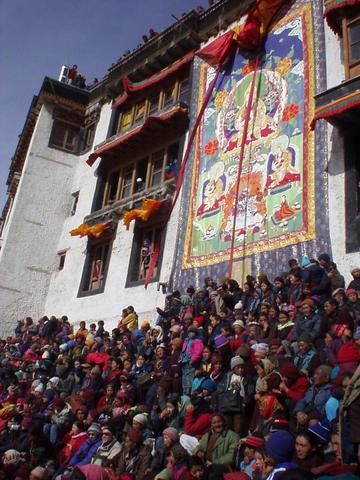 At most if not all of the gompa-festivals, the gompa reveals a large image of important figures of Tibetan Buddhism, which is kept rolled up the rest of the year.
At most if not all of the gompa-festivals, the gompa reveals a large image of important figures of Tibetan Buddhism, which is kept rolled up the rest of the year.
|
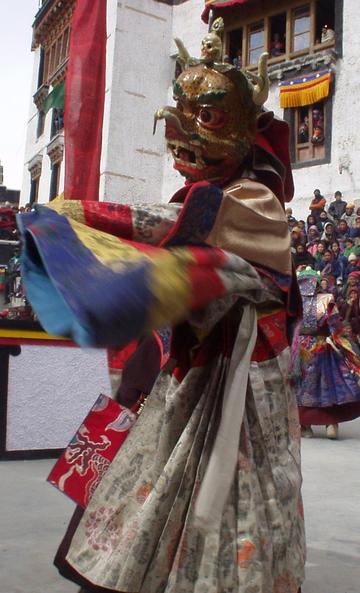 The center of the festival, however, was the dancing masked monks, like this one. They are made up to be like Tibetan gods; I never figured out who the bad guys were, however -- I asked a few times about fellows like this with scary eyes and pointy fangs, and they were good guys. Maybe they're all good guys, I don't know.
The center of the festival, however, was the dancing masked monks, like this one. They are made up to be like Tibetan gods; I never figured out who the bad guys were, however -- I asked a few times about fellows like this with scary eyes and pointy fangs, and they were good guys. Maybe they're all good guys, I don't know. |
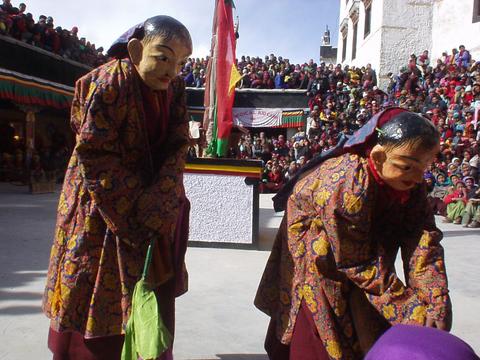 Another pair of dancing masked monks.
Another pair of dancing masked monks. |
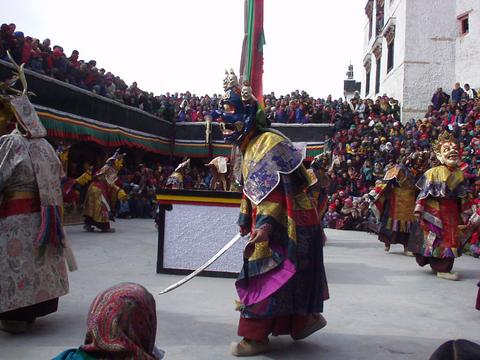 The festival happened in a central courtyard, as you can see here, with a large central pillar with and a flag. The gompa at Likir, which had a festival a month later, had a similar layout.
The festival happened in a central courtyard, as you can see here, with a large central pillar with and a flag. The gompa at Likir, which had a festival a month later, had a similar layout. |
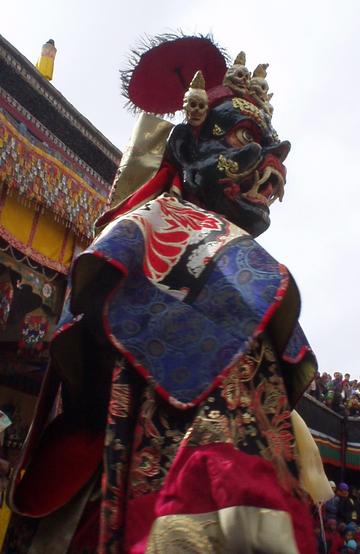 Another scary-but-probably-good character.
Another scary-but-probably-good character. |
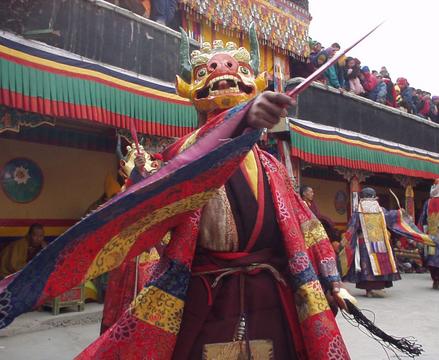 One with swords -- I was up front, so much so that I occasionally had to duck to make sure I didn't get poked in the eye by one of the sword-weilding characters.
One with swords -- I was up front, so much so that I occasionally had to duck to make sure I didn't get poked in the eye by one of the sword-weilding characters. |
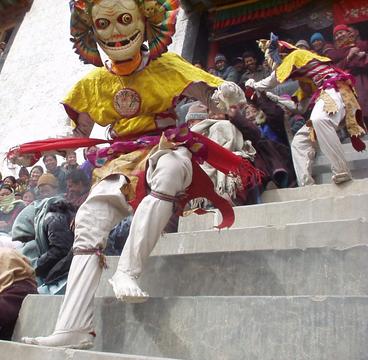 These two (there were two more) provided crowd-pleasing comic relief from the people with fangs, by running around and sitting on people (usually the most dignified looking old women) and dousing them with their poof-balls of white powder that they held in their hands.
These two (there were two more) provided crowd-pleasing comic relief from the people with fangs, by running around and sitting on people (usually the most dignified looking old women) and dousing them with their poof-balls of white powder that they held in their hands. |
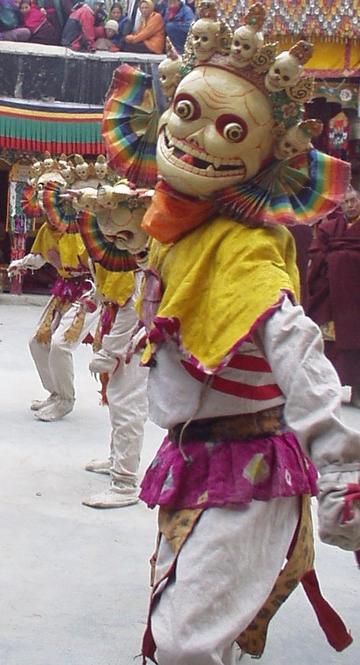 The whole comic relief gang.
The whole comic relief gang. |
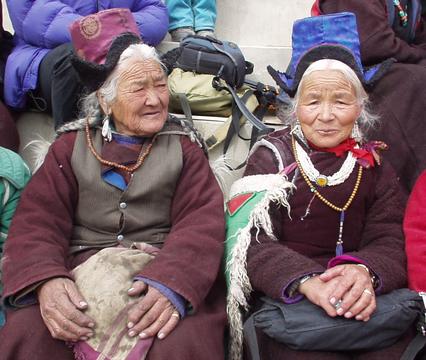 Old Ladakhi women. I don't think either of these two got sat on.
Old Ladakhi women. I don't think either of these two got sat on. |
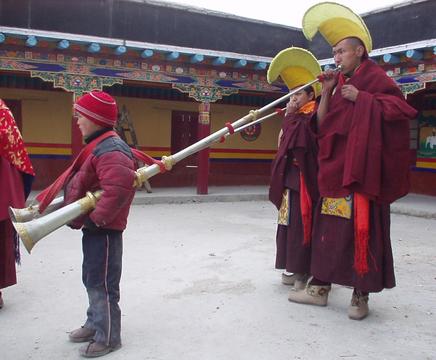 These large, ungainly horns were played in conjunction with drums for most of the festival. They sounded like a tuba, but more, um... ungainly.
These large, ungainly horns were played in conjunction with drums for most of the festival. They sounded like a tuba, but more, um... ungainly. |
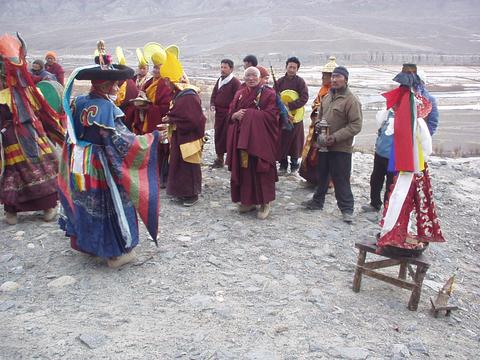 After the festival, there was a ritual burning of a human figure, some kind of banishment of bad fortune. This is the preparation for the ceremony, with the figure at the right hand side.
After the festival, there was a ritual burning of a human figure, some kind of banishment of bad fortune. This is the preparation for the ceremony, with the figure at the right hand side. |
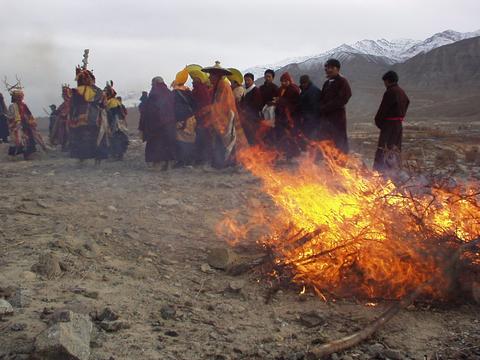 After lighting the figure, the procession quickly retreated back to the monastery.
After lighting the figure, the procession quickly retreated back to the monastery. |
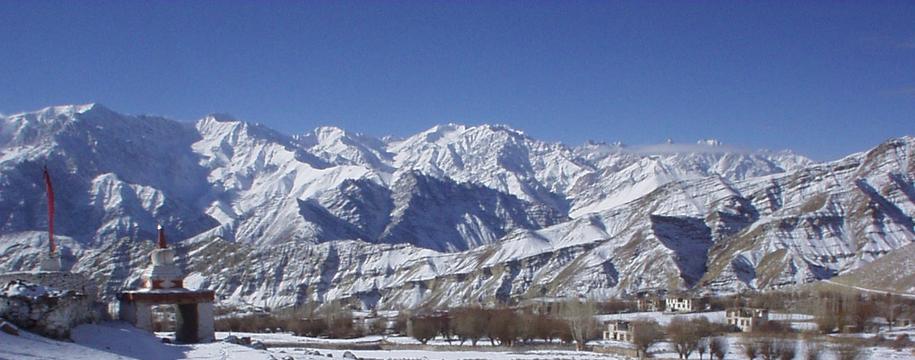 This was the view out the front door of the guesthouse where I stayed in the village of Likir; the structure is a stupa, a Tibetan Buddhist place of prayer.
This was the view out the front door of the guesthouse where I stayed in the village of Likir; the structure is a stupa, a Tibetan Buddhist place of prayer. |
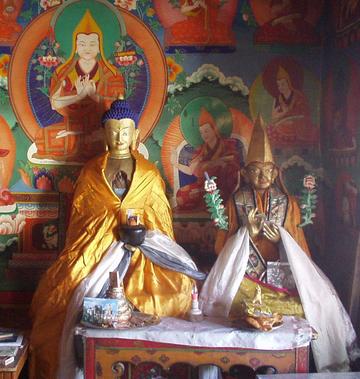 Buddhist idols in the Likir gompa.
Buddhist idols in the Likir gompa. |
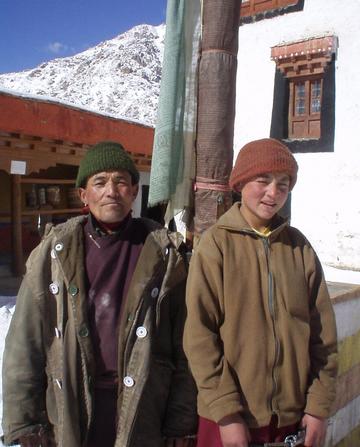 At right is Stanzin, the monk who showed me around the Likir monastery. He spoke English fairly well; there is a New Yorker named Chris who spends a good part of each year at the gompa and teaches English and Buddhism. The other guy is some other monk who just jumped into the picture.
At right is Stanzin, the monk who showed me around the Likir monastery. He spoke English fairly well; there is a New Yorker named Chris who spends a good part of each year at the gompa and teaches English and Buddhism. The other guy is some other monk who just jumped into the picture. |
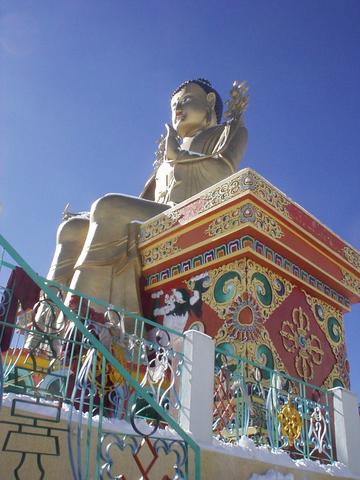 The giant gold buddha at the Likir gompa. You can see this thing from a mile away.
The giant gold buddha at the Likir gompa. You can see this thing from a mile away. |
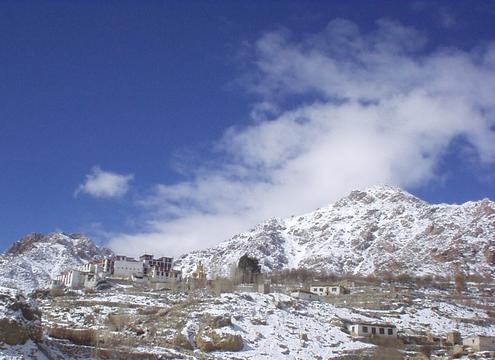 The Likir gompa, from about a mile away. You can see the gold buddha to the right (you may need to click on the image -- and maybe click again -- for the larger versions).
The Likir gompa, from about a mile away. You can see the gold buddha to the right (you may need to click on the image -- and maybe click again -- for the larger versions). |
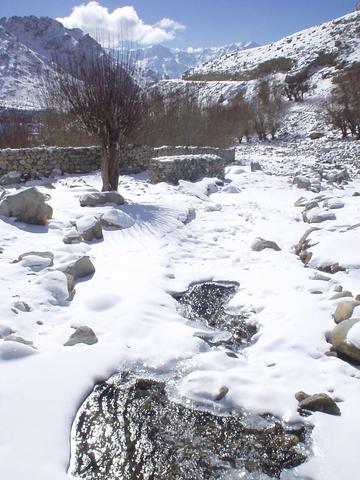 Stream in the valley below the Likir Gompa.
Stream in the valley below the Likir Gompa. |
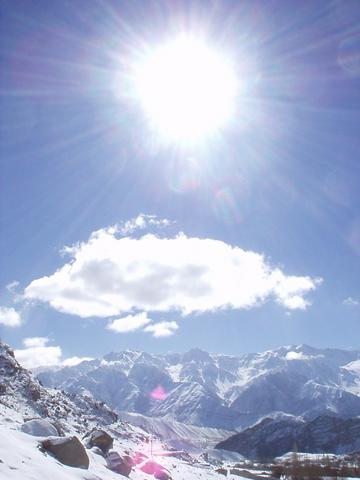 The sun was very strong in Ladakh; when it set, or when I walked into a shaded valley, the temperature drop was stunning.
The sun was very strong in Ladakh; when it set, or when I walked into a shaded valley, the temperature drop was stunning. |
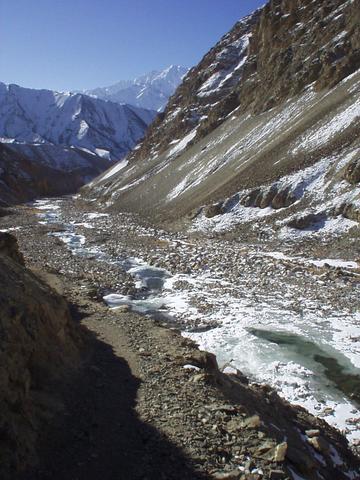 I hiked between the villages of Likir and Alchi, and this was one of the valleys between the two.
I hiked between the villages of Likir and Alchi, and this was one of the valleys between the two. |
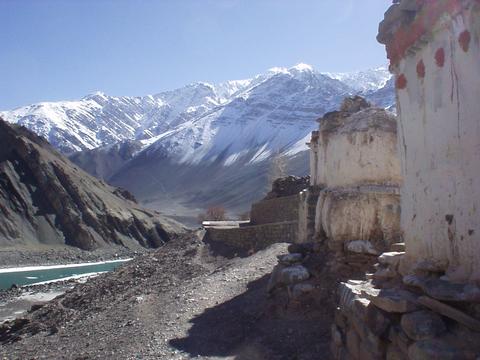 Stupas behind the Alchi Gompa; that's the Indus river at left.
Stupas behind the Alchi Gompa; that's the Indus river at left. |
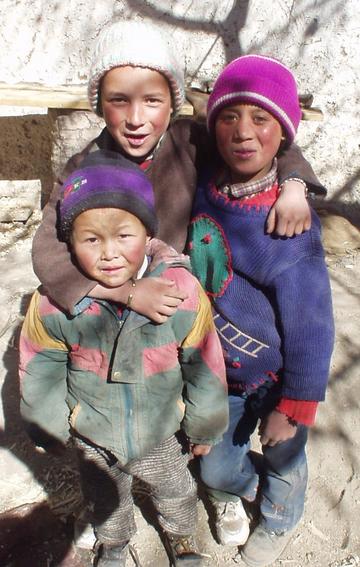 Children in the town of Alchi.
Children in the town of Alchi. |
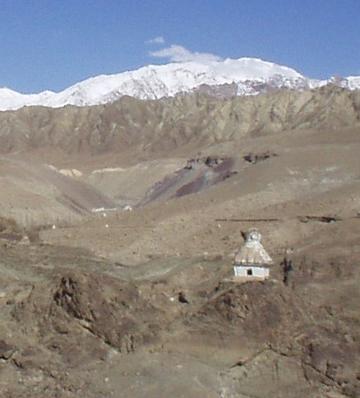 The same boy explained that this stupa was for burial; I don't know for whom, however.
The same boy explained that this stupa was for burial; I don't know for whom, however. |
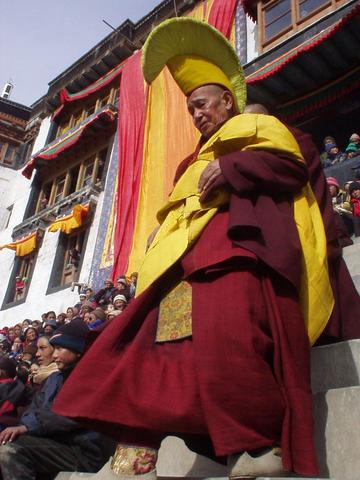 Monk at the Spituk festival, near Leh. In Ladakh, every Buddhist gompa (monastery) has an annual festival, usually in the wintertime when there isn't much farming to do. The festivals involve a lot of dancing and storytelling, involving old Tibetan gods that have been incorporated into Tibetan Buddhism.
Monk at the Spituk festival, near Leh. In Ladakh, every Buddhist gompa (monastery) has an annual festival, usually in the wintertime when there isn't much farming to do. The festivals involve a lot of dancing and storytelling, involving old Tibetan gods that have been incorporated into Tibetan Buddhism. |
 Women watching the winter festival at the Spituk Gompa, just outside of Leh in Ladakh, northern India.
Women watching the winter festival at the Spituk Gompa, just outside of Leh in Ladakh, northern India. Monk in costume for the winter festival at the Spituk Gompa, just outside of Leh in Ladakh, northern India.
Monk in costume for the winter festival at the Spituk Gompa, just outside of Leh in Ladakh, northern India. Monk carrying a Tibetan great horn, or dungchen, at the Spituk monastery winter festival.
Monk carrying a Tibetan great horn, or dungchen, at the Spituk monastery winter festival. Monk playing Tibetan cymbals (rolmo), at the Spituk monastery winter festival.
Monk playing Tibetan cymbals (rolmo), at the Spituk monastery winter festival. Tibetan god painted on the wall of the Gompa at Likir, Ladakh.
Tibetan god painted on the wall of the Gompa at Likir, Ladakh. Ladakhi woman watching the spectacle at the Spituk Winter Festival.
Ladakhi woman watching the spectacle at the Spituk Winter Festival. The crowd watching the Spituk Festival. Can you spot the two Polish people?
The crowd watching the Spituk Festival. Can you spot the two Polish people? The bus from Leh to Likir, a small town in Ladakh, after it dropped me off in Likir.
The bus from Leh to Likir, a small town in Ladakh, after it dropped me off in Likir. Monks playing gyalings at the winter festival at the Spituk Gompa, just outside of Leh in Ladakh, northern India.
Monks playing gyalings at the winter festival at the Spituk Gompa, just outside of Leh in Ladakh, northern India. Monk in costume for the winter festival at the Spituk Gompa, just outside of Leh in Ladakh, northern India.
Monk in costume for the winter festival at the Spituk Gompa, just outside of Leh in Ladakh, northern India. Monk in red-faced mask (perhaps representing the god Pektse?) at the winter festival at the Spituk Gompa, just outside of Leh in Ladakh, northern India.
Monk in red-faced mask (perhaps representing the god Pektse?) at the winter festival at the Spituk Gompa, just outside of Leh in Ladakh, northern India. The sky above the Spituk Monastery, near Leh.
The sky above the Spituk Monastery, near Leh. The gompa of Leh.
The gompa of Leh. Ladakhi man weaving a woolen mat in the town of Alchi.
Ladakhi man weaving a woolen mat in the town of Alchi. Stupas outside of the town of Alchi. A boy that walked with me for a little while explained that (at least in the old days), a mountain would get upset and now allow the farmers' crops to grow, and so they would build stupas like these to combat the mountain's ill will.
Stupas outside of the town of Alchi. A boy that walked with me for a little while explained that (at least in the old days), a mountain would get upset and now allow the farmers' crops to grow, and so they would build stupas like these to combat the mountain's ill will. Men playing drums and tibetan horn at the 2003 Spituk Festival; these two (not the kid) played music at the beginning and ending of each day of the festival.
Men playing drums and tibetan horn at the 2003 Spituk Festival; these two (not the kid) played music at the beginning and ending of each day of the festival. Ladakhi monk blessing animals: there was a horse, a ram, and a dog.
Ladakhi monk blessing animals: there was a horse, a ram, and a dog. The horse and the ram were more or less willing participants in the festival, but the dog was displeased to be present, snapping and growling at anyone who came near; the monk here was holding him on a very short chain.
The horse and the ram were more or less willing participants in the festival, but the dog was displeased to be present, snapping and growling at anyone who came near; the monk here was holding him on a very short chain. The offering of gifts was a big part of the festival, with the public offering ceremonial white cloths (they have a name, I forget), oil, and other things to the monastery, and with the older monks giving small amounts of money to the young monks.
The offering of gifts was a big part of the festival, with the public offering ceremonial white cloths (they have a name, I forget), oil, and other things to the monastery, and with the older monks giving small amounts of money to the young monks. The recession of the music-playing monks at the intermission of the second day of the festival; the main instruments were drums (the green things) and very large horns.
The recession of the music-playing monks at the intermission of the second day of the festival; the main instruments were drums (the green things) and very large horns. At most if not all of the gompa-festivals, the gompa reveals a large image of important figures of Tibetan Buddhism, which is kept rolled up the rest of the year.
At most if not all of the gompa-festivals, the gompa reveals a large image of important figures of Tibetan Buddhism, which is kept rolled up the rest of the year.
 The center of the festival, however, was the dancing masked monks, like this one. They are made up to be like Tibetan gods; I never figured out who the bad guys were, however -- I asked a few times about fellows like this with scary eyes and pointy fangs, and they were good guys. Maybe they're all good guys, I don't know.
The center of the festival, however, was the dancing masked monks, like this one. They are made up to be like Tibetan gods; I never figured out who the bad guys were, however -- I asked a few times about fellows like this with scary eyes and pointy fangs, and they were good guys. Maybe they're all good guys, I don't know. Another pair of dancing masked monks.
Another pair of dancing masked monks. The festival happened in a central courtyard, as you can see here, with a large central pillar with and a flag. The gompa at Likir, which had a festival a month later, had a similar layout.
The festival happened in a central courtyard, as you can see here, with a large central pillar with and a flag. The gompa at Likir, which had a festival a month later, had a similar layout. Another scary-but-probably-good character.
Another scary-but-probably-good character. One with swords -- I was up front, so much so that I occasionally had to duck to make sure I didn't get poked in the eye by one of the sword-weilding characters.
One with swords -- I was up front, so much so that I occasionally had to duck to make sure I didn't get poked in the eye by one of the sword-weilding characters. These two (there were two more) provided crowd-pleasing comic relief from the people with fangs, by running around and sitting on people (usually the most dignified looking old women) and dousing them with their poof-balls of white powder that they held in their hands.
These two (there were two more) provided crowd-pleasing comic relief from the people with fangs, by running around and sitting on people (usually the most dignified looking old women) and dousing them with their poof-balls of white powder that they held in their hands. The whole comic relief gang.
The whole comic relief gang. Old Ladakhi women. I don't think either of these two got sat on.
Old Ladakhi women. I don't think either of these two got sat on. These large, ungainly horns were played in conjunction with drums for most of the festival. They sounded like a tuba, but more, um... ungainly.
These large, ungainly horns were played in conjunction with drums for most of the festival. They sounded like a tuba, but more, um... ungainly. After the festival, there was a ritual burning of a human figure, some kind of banishment of bad fortune. This is the preparation for the ceremony, with the figure at the right hand side.
After the festival, there was a ritual burning of a human figure, some kind of banishment of bad fortune. This is the preparation for the ceremony, with the figure at the right hand side. After lighting the figure, the procession quickly retreated back to the monastery.
After lighting the figure, the procession quickly retreated back to the monastery. This was the view out the front door of the guesthouse where I stayed in the village of Likir; the structure is a stupa, a Tibetan Buddhist place of prayer.
This was the view out the front door of the guesthouse where I stayed in the village of Likir; the structure is a stupa, a Tibetan Buddhist place of prayer. Buddhist idols in the Likir gompa.
Buddhist idols in the Likir gompa. At right is Stanzin, the monk who showed me around the Likir monastery. He spoke English fairly well; there is a New Yorker named Chris who spends a good part of each year at the gompa and teaches English and Buddhism. The other guy is some other monk who just jumped into the picture.
At right is Stanzin, the monk who showed me around the Likir monastery. He spoke English fairly well; there is a New Yorker named Chris who spends a good part of each year at the gompa and teaches English and Buddhism. The other guy is some other monk who just jumped into the picture. The giant gold buddha at the Likir gompa. You can see this thing from a mile away.
The giant gold buddha at the Likir gompa. You can see this thing from a mile away. The Likir gompa, from about a mile away. You can see the gold buddha to the right (you may need to click on the image -- and maybe click again -- for the larger versions).
The Likir gompa, from about a mile away. You can see the gold buddha to the right (you may need to click on the image -- and maybe click again -- for the larger versions). Stream in the valley below the Likir Gompa.
Stream in the valley below the Likir Gompa. The sun was very strong in Ladakh; when it set, or when I walked into a shaded valley, the temperature drop was stunning.
The sun was very strong in Ladakh; when it set, or when I walked into a shaded valley, the temperature drop was stunning. I hiked between the villages of Likir and Alchi, and this was one of the valleys between the two.
I hiked between the villages of Likir and Alchi, and this was one of the valleys between the two. Stupas behind the Alchi Gompa; that's the Indus river at left.
Stupas behind the Alchi Gompa; that's the Indus river at left. Children in the town of Alchi.
Children in the town of Alchi. The same boy explained that this stupa was for burial; I don't know for whom, however.
The same boy explained that this stupa was for burial; I don't know for whom, however. Monk at the Spituk festival, near Leh. In Ladakh, every Buddhist gompa (monastery) has an annual festival, usually in the wintertime when there isn't much farming to do. The festivals involve a lot of dancing and storytelling, involving old Tibetan gods that have been incorporated into Tibetan Buddhism.
Monk at the Spituk festival, near Leh. In Ladakh, every Buddhist gompa (monastery) has an annual festival, usually in the wintertime when there isn't much farming to do. The festivals involve a lot of dancing and storytelling, involving old Tibetan gods that have been incorporated into Tibetan Buddhism.